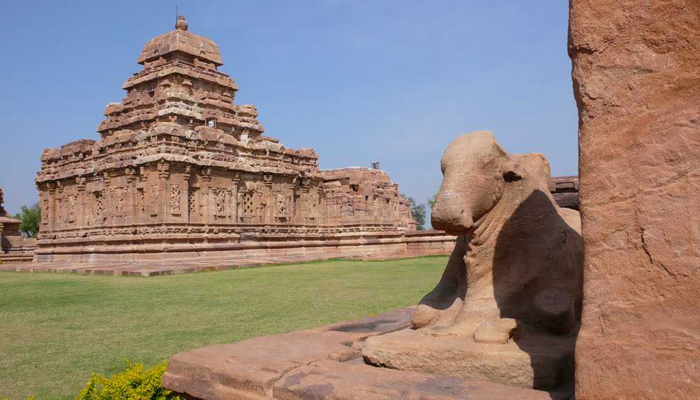In Karnataka, Pattadakal is a small town that is renowned for its ancient temples. Located near Badami and Aihole, Pattadakal Temple can be easily reached by regular buses or private taxis from the major towns and cities of Karnataka. The Temples of Pattadakal, exhibhit the zenith of 'Vesara' style of Hindu temple architecture. Owing to its incredible temples, Pattadakal was titled a World Heritage Site by UNESCO in 1987.
Pattadakal had once been the rich capital of the Chalukyas. During 7th - 8th century, Pattadakal Temples were got constructed by the Chalukya rulers. Portraying the rare specimen, the temples depict a wonderful blend of Dravidian (South-Indian) and Nagara (North-Indian) architectural styles. The phrase 'beauty in ruins' goes exactly with the town of Pattadakal. The beautiful settlement appears majestic with its series of nine temples.
The sculptural art of these temples is marked by classiness of the Chalukya dynasty. Pattadakal emerges as a heavenly site with its superb architectural marvels in a picture-perfect lane. The distinct styles and patterns of various temples reveal the designers' intelligence at a stretch. The temples of Pattadakal receive myriad number of tourists, who come from the distant lands, round the year.
Out of all, four temples are built in Dravidian style, four in Nagara style and Papanatha Temple illustrates a perfect blend of both styles of architecture. In the 8th century, Kashivisvanatha Temple was constructed by the Rashtrakutas. Built in north Indian style, Galganatha Temple encompasses a sculpture of Lord Shiva killing the demon Andhakasura. Kasi Visweswara is another temple that boasts of the nagara style of architecture. The important ones are discussed below in detail.
Virupaksha Temple
In 745, Virupaksha Temple was built by Queen Lokamahadevi to celebrate her husband's victory (Vikramaditya II) over the Pallavas of Kanchi. The temple was erected on the structural lines of Kailashnath Temple (Kanchi); however Virupaksha became the brainwave for Kailashnath Temple at Ellora. The temple is renowned for its affluent structures like Lingodbhava, Nataraja, Ravananugraha and Ugranarasimha.
Mallikarjuna Temple
In 745, Mallikarjuna Temple was built by Trilokya Mahadevi, who was the second queen of Vikramaditya II. The purpose behind the erection of a temple was to commemorate the victory of the Chalukyas over the Pallavas. Mallikaarjuna Temple was modeled on the lines of Virupaksha Temple. The temple is celebrated for its artistic sculptures.
Papanatha Temple
Papanatha Temple is the only temple that has been designed on both north and south Indian styles of architecture. Containing a Nagara styled Vimanam, the temple dates back to 680 AD. Initially, the construction was started with Nagara style, but later it was switched to Dravidian style. The temple is famous for its sculptures that are imbibed from the scenes of Ramayana and Mahabharata.
Jain Temple
Sited on Pattadakal-Badami Road, Jain Temple was constructed by the Rashtrakutas of Manyakheta. Built in the Dravidian style, the temple comprises really beautiful sculptures. Perhaps, it was erected either by King Amoghavarsha I or his son Krishna II in the 9th century.
Jambulinga Temple
Built in Nagara style, Jambulinga Temple is built on the lines of Hucchimalli' Guddi at Aihole. The temple houses the image of Lord Shiva, Goddess Parvati along with Nandi. Jambulinga Temple has a horseshoe-shaped projection in its exteriors.
Sangamesvara Temple
Perhaps the oldest temple in the group, Sangameshvara Temple was built by King Vijayaditya Satyashraya during 697 -733 AD. This incomplete temple appeals with its colossal structure.
Location : Pattadakal, Near Badami and Aihole, Karnataka
Built in : 7th - 8th century
Significance : Regarded as World Heritage Site

